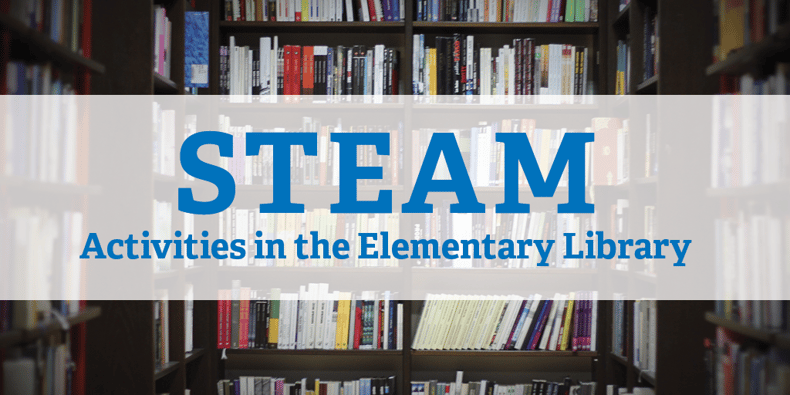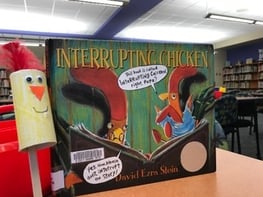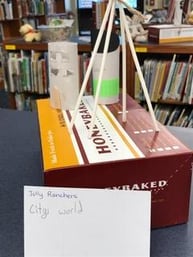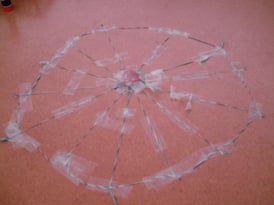
STEM (and now STEAM) has been an educational buzzword for a while now. Just in case you didn’t know, STEAM stands for Science, Technology, Engineering, Art, and Mathematics. Stop by any teacher lounge in any district at any grade level, and you may hear the teachers discussing what STEAM activities they are implementing. Though I am not a homeroom teacher, I have been able to build time into my curriculum for STEAM activities—and not any just STEAM activities, but ones tied to children’s literature. Let me share a few things I’ve done in the elementary library.
Engaging Younger Students With STEAM
 In my kindergarten library class, we read the picture book Interrupting Chicken by David Ezra Stein. We discussed what “interrupting” means and why it is troublesome in the classroom. The following week, each student made their own interrupting chicken to remind them to be patient listeners. We used toilet paper rolls, feathers, googly eyes, craft sticks, and hot glue to make the chickens. With the help of a library volunteer, we were able to create these in one class period—and the kids loved it. I teach in a small school that doesn’t have an art program, so the kids enjoyed getting to do something both creative and connected to our book. My overall intent was that they’d take their creations home and tell their parents about what we read in library. This was fun, simple, educational, and easy to implement, even with my time restraints.
In my kindergarten library class, we read the picture book Interrupting Chicken by David Ezra Stein. We discussed what “interrupting” means and why it is troublesome in the classroom. The following week, each student made their own interrupting chicken to remind them to be patient listeners. We used toilet paper rolls, feathers, googly eyes, craft sticks, and hot glue to make the chickens. With the help of a library volunteer, we were able to create these in one class period—and the kids loved it. I teach in a small school that doesn’t have an art program, so the kids enjoyed getting to do something both creative and connected to our book. My overall intent was that they’d take their creations home and tell their parents about what we read in library. This was fun, simple, educational, and easy to implement, even with my time restraints.
 In my third grade class, I have a yearly tradition: I read The Junkyard Wonders by Patricia Polacco at the beginning of school. It is a touching book about Mrs. Peterson, a teacher of misfit kids who teaches her students to believe in themselves. They are called “Junkyard Wonders,” and they go to a junkyard to find discarded items to create something new. After reading this book, I divide up the class into “tribes,” as Mrs. Peterson does in the book. Each tribe is given a baggie full of random items: paper clips, toilet paper rolls, scraps of paper, pipe cleaners, craft sticks, etc. Using only these items (plus scissors and glue), students are asked to create something new. After they’ve collaborated and created, they must then describe what they’ve made. This is a fun activity that promotes teamwork, engineering, creativity, and thinking outside the box. Plus, the final product offers a great opportunity for a writing assignment—i.e. write about what you created, write about how you created it, or write about how your tribe worked together to make this happen.
In my third grade class, I have a yearly tradition: I read The Junkyard Wonders by Patricia Polacco at the beginning of school. It is a touching book about Mrs. Peterson, a teacher of misfit kids who teaches her students to believe in themselves. They are called “Junkyard Wonders,” and they go to a junkyard to find discarded items to create something new. After reading this book, I divide up the class into “tribes,” as Mrs. Peterson does in the book. Each tribe is given a baggie full of random items: paper clips, toilet paper rolls, scraps of paper, pipe cleaners, craft sticks, etc. Using only these items (plus scissors and glue), students are asked to create something new. After they’ve collaborated and created, they must then describe what they’ve made. This is a fun activity that promotes teamwork, engineering, creativity, and thinking outside the box. Plus, the final product offers a great opportunity for a writing assignment—i.e. write about what you created, write about how you created it, or write about how your tribe worked together to make this happen.
 Finally, my fourth graders have been reading Harry Potter and the Sorcerer’s Stone with their classroom teacher. In honor of the book’s 20th anniversary, the specialists decided to have a Harry Potter week where all of us did an activity relating to the book series. I decided to try out a STEAM activity for the occasion. I pulled from the second book in the series, where we meet Aragog the spider. I divided each class into groups of two or three and gave each group a pack of dental floss, two paper clips, scotch tape, and a sheet of directions. Their assignment was to create Aragog’s spider web using just the materials provided. Afterwards, they had to fill out a lab sheet discussing how their group solved the problem. My fourth graders seemed to really enjoy this activity. They were engaged, their activity related to the book series they are reading, and they were able to use their collaboration and engineering skills. Best of all, they all took slightly different approaches to tackling this problem. I was very happy with the outcome of the fourth graders’ spider webs and the processes they used to create them.
Finally, my fourth graders have been reading Harry Potter and the Sorcerer’s Stone with their classroom teacher. In honor of the book’s 20th anniversary, the specialists decided to have a Harry Potter week where all of us did an activity relating to the book series. I decided to try out a STEAM activity for the occasion. I pulled from the second book in the series, where we meet Aragog the spider. I divided each class into groups of two or three and gave each group a pack of dental floss, two paper clips, scotch tape, and a sheet of directions. Their assignment was to create Aragog’s spider web using just the materials provided. Afterwards, they had to fill out a lab sheet discussing how their group solved the problem. My fourth graders seemed to really enjoy this activity. They were engaged, their activity related to the book series they are reading, and they were able to use their collaboration and engineering skills. Best of all, they all took slightly different approaches to tackling this problem. I was very happy with the outcome of the fourth graders’ spider webs and the processes they used to create them.
Teaching Students to Think Outside the Box
You may ask, “Why STEAM?” STEAM activities can help students think outside the box. Students learn to work in a team and create something new—without the help of a teacher. Students build confidence in themselves when they find they can complete a challenge, and learn to look at a problem in a different way. And of course, students get to dig into areas of study that sometimes get overshadowed by the day-to-day business of learning to read and write. My plan is to continue STEAM activities in the library with all grades. These fun and engaging learning opportunities are a great way for me to make connections between my students and the books we read in class.
Author’s note: If you’re intimidated about adding STEAM activities to your classroom, don’t be. Ask other teachers or go to the Internet—there are tons of ideas online. I used Pinterest and Teachers Pay Teachers to help me. And keep in mind, you can tweak the ideas you find online to fit your audience.
Want even more STEM inspiration? Check out these STEM activities on MimioConnect, an interactive educator community with lessons and activities created by educators for educators.



